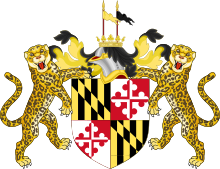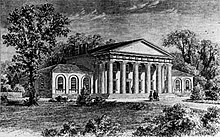George Washington Parke Custis
George Washington Parke Custis (April 30, 1781 – October 10, 1857) was an American antiquarian, author, playwright, and plantation owner.
Custis also wrote historical plays about Virginia, delivered a number of patriotic addresses, and was the author of the posthumously published Recollections and Private Memoirs of George Washington (1860).
They inherited Arlington House and the plantation surrounding it, but the property was soon confiscated by the federal government during the Civil War.
After regaining Arlington, George Washington Custis Lee immediately sold it back to the federal government for its market value.
Custis was born on April 30, 1781, at his mother's family home, Mount Airy, which survives in Rosaryville State Park in Prince George's County, Maryland.
[2][3][4] Custis's two oldest sisters, Elizabeth and Martha, remained at Abingdon with their widowed mother, who in 1783 married Dr. David Stuart, an Alexandria physician and associate of George Washington.
George Washington repeatedly expressed frustration with young Custis and his inability to improve the youth's attitude.
Upon young Custis's return to Mount Vernon after only one term at St. John's, George Washington sent him to his mother and stepfather (Dr. David Stuart) at Hope Park, writing, "He appears to me to be moped and Stupid, says nothing, and is always in some hole or corner excluded from the Company.
"[6] His grandfather gave him a sword when "Wash" Custis received a Virginia military commission shortly before the turn of the century.
and his daughter Eleanor (Nelly) Parke Custis (later Lewis) grew up at Mount Vernon, the home of Martha and George Washington.
Mary Anna Custis married her distant cousin, United States Army Lieutenant Robert E. Lee in June 1831.
On July 16, 1862, the United States Congress passed legislation authorizing the purchase of land for national cemeteries for military dead.
While Private William Henry Christmas became the first Union soldier buried at Arlington on May 13, 1864, formal authorization for burials did not occur until June 15, 1864.
In January 1799, Custis accepted a commission as a cornet in the United States Army and was promoted to second lieutenant in March.
[citation needed] During the War of 1812, Custis, despite physical infirmities, assisted in the firing of an artillery piece to help defend Washington, D.C., from the British during the Battle of Bladensburg.
[16] With Mrs. Madison, it is reported that Custis initiated the saving of George Washington's portrait from the Executive Mansion (The White House) from the British troops.
In the 1820 U.S. Federal Census, he owned 116 slaves in New Kent County, Virginia in land he inherited from his father and hired a steward to manage.
[30] In 1836, Custis established a mill on Four Mile Run and Columbia Pike, in what a decade later became Arlington County, Virginia, as described below.
It ground grain for nearby farmers, and eventually became the site of an early skirmish in the American Civil War.
[31][32] In 1846, the federal government retroceded to the state of Virginia the portion of the District of Columbia that was south and west of the Potomac River, which at the time contained the city and county of Alexandria.
In addition to the Lingan eulogy, he delivered The Celebration of the Russian Victories, in Georgetown, District of Columbia; on June 5, 1813 (1813).
Two of Custis's plays, The Indian Prophecy; or Visions of Glory (1827) and Pocahontas; or, The Settlers of Virginia (1830), were published during his lifetime.
Custis wrote a series of biographical essays about his adoptive father that were compiled and posthumously published in 1859 and 1860, after his own death in 1857, as Recollections and Private Memoirs of Washington.
[43] Then-Lt. Col. Robert E. Lee, named as the will's executor, took a two-year leave from his army post in Texas to settle the estate.
During this period Lee was ordered to lead troops to quash John Brown's raid on Harpers Ferry.
[44] At the outbreak of the American Civil War, Union Army forces seized the 1,100-acre (4.5 km2) Arlington Plantation for strategic reasons (protection of the river and national capital).
[45][46][47] On December 29, 1862, Robert Lee freed all of the remaining Custis slaves, as this was the last day within the five year limit he was allowed to retain them.
[48] In 1864, Montgomery C. Meigs, Quartermaster General of the United States Army, appropriated some parts of Arlington Plantation for use as a military burial ground.

" The Washington Family " by Edward Savage , painted between 1789 and 1796, shows (from left to right): George Washington Parke Custis, George Washington , Nelly Custis , Martha Washington , and an enslaved servant (probably William Lee or Christopher Sheels ).





